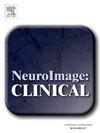Spatial and signal features of white matter integrity and associations with clinical factors: A CARDIA brain MRI study
IF 3.4
2区 医学
Q2 NEUROIMAGING
引用次数: 0
Abstract
White matter hyperintensities (WMH) may be indicative of age-related cerebrovascular diseases and contribute to cognitive and functional decline. Normal appearing WM (NAWM) adjacent to WMH, termed “penumbra,” is known to be vulnerable to future WMH pathology. WM integrity can be evaluated using multiple magnetic resonance imaging (MRI) modalities. We aimed to identify MRI features predictive of WMH growth and to compare the implications of these features based on spatial proximity to existing WMH versus signal features in baseline NAWM. We used baseline and 5-year follow-up MRI scans in 485 middle-aged participants form the Coronary Artery Risk Development in Young Adults (CARDIA). Multimodal MRI at baseline, including fluid attenuated inversion recovery (FLAIR), diffusion tensor imaging (DTI), and cerebral blood flow (CBF), was measured within WM ROIs including baseline WMH and regions that later developed into new WMH, within and external to the baseline penumbra. Overall, we found that 80% of new WMH appeared within the baseline penumbra. We also found lower fractional anisotropy (FA) and CBF and higher FLAIR and median diffusivity (MD) in NAWM at baseline in regions with subsequent WMH growth compared to those without WMH growth. For NAWM regions defined by signal features, subthreshold FA and suprathreshold MD and FLAIR abnormality at baseline were the most robust predictors of WMH growth. Baseline systolic blood pressure had significant associations with baseline abnormalities in NAWM and subsequently with cognitive decline, particularly for FA and MD measures. The findings support the use of DTI as the predictor of WMH growth, which is correlated with subtle, adverse WM alterations and cognitive function years before developing to WMH. The results may contribute to future clinical trials aimed at preserving WM integrity.
白质完整性的空间和信号特征及其与临床因素的关联:一项CARDIA脑MRI研究
白质高强度(WMH)可能是年龄相关脑血管疾病的指示,并有助于认知和功能下降。与WMH相邻的正常WM (NAWM),称为“半暗带”,已知易受未来WMH病理的影响。WM的完整性可以通过多种磁共振成像(MRI)方式进行评估。我们的目的是确定预测WMH生长的MRI特征,并比较这些特征的含义,这些特征基于与现有WMH的空间接近度与基线NAWM的信号特征。我们对485名中年人进行了基线和5年随访MRI扫描,这些中年人形成了年轻人冠状动脉风险发展(CARDIA)。基线时的多模态MRI,包括液体衰减反转恢复(FLAIR)、弥散张量成像(DTI)和脑血流量(CBF),在WM roi内进行测量,包括基线WMH和后来发展为新WMH的区域,在基线半影内和外。总的来说,我们发现80%的新WMH出现在基线半影内。我们还发现,与没有WMH生长的地区相比,在WMH随后生长的地区,基线时NAWM的分数各向异性(FA)和CBF较低,FLAIR和中位扩散系数(MD)较高。对于由信号特征定义的NAWM区域,阈下FA和阈上MD以及基线时的FLAIR异常是WMH生长最可靠的预测因子。基线收缩压与NAWM的基线异常以及随后的认知能力下降有显著关联,尤其是FA和MD测量。研究结果支持使用DTI作为WMH增长的预测因子,这与微妙的、不利的WM改变和发展为WMH前几年的认知功能相关。该结果可能有助于未来旨在保持WM完整性的临床试验。
本文章由计算机程序翻译,如有差异,请以英文原文为准。
求助全文
约1分钟内获得全文
求助全文
来源期刊

Neuroimage-Clinical
NEUROIMAGING-
CiteScore
7.50
自引率
4.80%
发文量
368
审稿时长
52 days
期刊介绍:
NeuroImage: Clinical, a journal of diseases, disorders and syndromes involving the Nervous System, provides a vehicle for communicating important advances in the study of abnormal structure-function relationships of the human nervous system based on imaging.
The focus of NeuroImage: Clinical is on defining changes to the brain associated with primary neurologic and psychiatric diseases and disorders of the nervous system as well as behavioral syndromes and developmental conditions. The main criterion for judging papers is the extent of scientific advancement in the understanding of the pathophysiologic mechanisms of diseases and disorders, in identification of functional models that link clinical signs and symptoms with brain function and in the creation of image based tools applicable to a broad range of clinical needs including diagnosis, monitoring and tracking of illness, predicting therapeutic response and development of new treatments. Papers dealing with structure and function in animal models will also be considered if they reveal mechanisms that can be readily translated to human conditions.
 求助内容:
求助内容: 应助结果提醒方式:
应助结果提醒方式:


